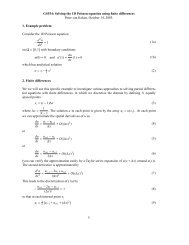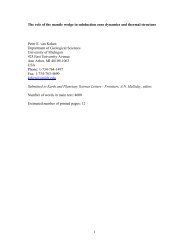Quantitative paleoenvironmental and paleoclimatic reconstruction ...
Quantitative paleoenvironmental and paleoclimatic reconstruction ...
Quantitative paleoenvironmental and paleoclimatic reconstruction ...
You also want an ePaper? Increase the reach of your titles
YUMPU automatically turns print PDFs into web optimized ePapers that Google loves.
ARTICLE IN PRESS<br />
16 N.D. Sheldon, N.J. Tabor / Earth-Science Reviews xxx (2009) xxx–xxx<br />
where the st<strong>and</strong>ard error (SE) is ±4.4°C, S is salinization (Table 3),<br />
<strong>and</strong> R 2 =0.37 for the empirical fit. The underlying principle is that<br />
alkali elements (K <strong>and</strong> Na) are typically accumulated in desert<br />
settings, which usually have relatively low MAT (even if they are<br />
seasonally or daily high). Thus, paleosols with high salinization ratios<br />
should have low MAT values. The relationship is applicable to lowl<strong>and</strong><br />
settings <strong>and</strong> moderate soil formation times (b100 Ka). It is not<br />
applicable to hillslope, montane, wetl<strong>and</strong>, or tropical (e.g., laterites)<br />
paleosols (Sheldon et al., 2002). A second Inceptisol-specific (~Protosol)<br />
relationship between MAT <strong>and</strong> “clayeyness” (Al/Si; Table 3) of<br />
the Bw or Bt horizon has also been proposed:<br />
Tð ○ CÞ =46:9C +4 ð25Þ<br />
where the SE is ±0.6 °C, C is clayeyness (Table 3), <strong>and</strong> R 2 =0.96<br />
(Sheldon, 2006c) for the empirical fit. Though Eq. (24) is relatively<br />
imprecise, the relationship is highly significant (t-test=8.5154,<br />
F-test = 72.58) <strong>and</strong> when applied to appropriate paleosols, gives<br />
results that are consistent with paleotemperature estimates based<br />
on leaf-margin <strong>and</strong> nearest living relative estimates from plants<br />
(Sheldon et al., 2002; Sheldon <strong>and</strong> Retallack, 2004; Sheldon, 2009). It<br />
has been applied to Cenozoic (Sheldon et al., 2002; Sheldon <strong>and</strong><br />
Retallack, 2004; Hamer et al., 2007b), Mesozoic (Retallack, 2005a),<br />
<strong>and</strong> Paleozoic (Sheldon, 2005) paleosols. The more precise Inceptisol-only<br />
Eq. (25) is potentially applicable over a wider range of<br />
estimated paleotemperatures, though Inceptisol-like paleosols are<br />
typically rare at very high or very low MATconditions. Nonetheless, it<br />
also gives paleotemperature results that are consistent with independent<br />
estimates based on fossil floras <strong>and</strong> faunas (Hamer et al.,<br />
2007a). The Inceptisol paleothermometer has been applied to<br />
Quaternary paleosols from Hawai'i (Sheldon, 2006c), Miocene<br />
paleosols (Hamer et al., 2007a), <strong>and</strong> Eocene–Oligocene transition<br />
paleosols (Sheldon, 2009). The primary weakness of both elementbased<br />
paleothermometers is that a variety of processes, including<br />
some not related to temperature, may alter chemical composition, so<br />
care is needed not to overinterpret results based solely on these<br />
approaches. As with many of the proxies that we are discussing, if<br />
possible, results should be verified using multiple proxies.<br />
5.5. Paleoprecipitation<br />
A variety of different quantitative proxies have been developed for<br />
estimating mean annual precipitation (MAP). Water availability is one of<br />
the key factors in determining the relative effectiveness of many<br />
pedogenic processes. For example, leaching of base cations is limited in<br />
arid settings (Retallack, 2001b) <strong>and</strong> enhanced in humid settings (e.g.,<br />
Sayyed <strong>and</strong> Hundekari, 2006). A variety of different paleoprecipitation<br />
proxies have been developed, all based on empirical relationships derived<br />
from modern soils. Each of the proxies that we will discuss is based on the<br />
properties of a single horizon or soil feature, so which proxy is most<br />
appropriate for a given setting will depend on what type of paleosol is<br />
being analyzed. Examples to be discussed include proxies based the iron<br />
content of Mn nodules in Vertisols, the depth to a Bk horizon below a<br />
paleosol surface, <strong>and</strong> the chemical composition of a Bw/Bt horizon.<br />
5.5.1. Content of Fe–Mn nodules in vertisols<br />
Stiles et al. (2001) studied a modern climosequence developed on<br />
the Texas Gulf Coastal Plain. Most of the soils there are Vertisols forming<br />
under modern MAP ranging from 800 to 1500 mm yr −1 (Stiles et al.,<br />
2001). They also observed that Fe–Mn nodules were common in the soils<br />
<strong>and</strong> hypothesized that the iron content corresponds to mean annual<br />
precipitation values (Fe TOT as a whole number % value, i.e., 20, not 0.2):<br />
<br />
P mm yr − 1<br />
= 654:4 + 31:5 Fe TOT ð26Þ<br />
where R 2 =0.92 for the empirical relationship (Stiles et al., 2001).<br />
They then applied the relationship to Fe–Mn nodules in Paleozoic<br />
paleosols, yielding inferred moisture regime results that correspond<br />
well with field characteristics of the paleosols <strong>and</strong> with qualitative<br />
observations based on comparisons to modern analogues. Stiles et al.<br />
(2001) did not find that their results correspond well to estimates<br />
based on depth to the Bk horizon (see Section 5.5.2) <strong>and</strong> found the Bk<br />
depth generally underestimated the modern known precipitation<br />
values. This method seems to be viable for paleo-Vertisols, however, it<br />
is unclear how common authigenic Fe–Mn nodules are given that<br />
there are relatively few reported occurrences (see references in Stiles<br />
et al., 2001), so its applicability may be somewhat limited.<br />
5.5.2. Depth to Bk horizon<br />
CaCO 3 is highly soluble <strong>and</strong> both Ca 2+ <strong>and</strong> CO 3 2− /HCO 3 − are readily<br />
mobilizedbothingroundwater<strong>and</strong>insoilsolutions,sothepresenceof<br />
CaCO 3 in a soil or paleosol indicates at least some degree of aridity<br />
(perhaps just seasonally), because under wetter conditions carbonate<br />
would not be stable or form authigenically. Jenny <strong>and</strong> Leonard (1935) <strong>and</strong><br />
Jenny (1941) first recognized that there was a relationship between the<br />
depth below the surface of modern soils to their Bk horizon (carbonatebearing)<br />
<strong>and</strong> MAP in Great Plains soils. Arkley (1963) further exp<strong>and</strong>ed<br />
observations of the relationship by considering more arid Mojave Desert<br />
settings <strong>and</strong> found the same relationship. Retallack (1994) combined<br />
Jenny's (1941) <strong>and</strong> Arkley's (1963) data <strong>and</strong> other literature data (n=317<br />
in total) <strong>and</strong> fit a regression line to it that related depth to the Bk horizon to<br />
MAP. That relationship was widely applied to paleosols ranging in age<br />
from Paleozoic to the Quaternary (e.g., examples in Retallack et al., 2000;<br />
Retallack, 2001b). Factors to consider before applying the relationship to<br />
paleosols include erosion of the paleosols prior to burial, post-burial<br />
compaction, <strong>and</strong> the effect of elevated atmospheric CO 2 levels (models of<br />
Bk horizon formation suggest that they will form deeper in the profile at<br />
significantly elevated CO 2 levels; McFadden et al., 1991). Erosion may be<br />
dealt with through careful stratigraphy <strong>and</strong> consistent application of the<br />
proxy (e.g., tops of soils are always measured from the surface that the<br />
highest root traces emanate down from). Compaction may be dealt with<br />
as described above (see Section 2.2.1). There are many means of<br />
reconstructing past CO 2 levels including using isotopic data from paleosols<br />
(see Section 7.4.3.1). In general though, this is only a concern for<br />
Ordovician–Silurian <strong>and</strong> Jurassic–Cretaceous paleosols (e.g., Berner <strong>and</strong><br />
Kothavala, 2001), <strong>and</strong> for some Precambrian paleosols (Sheldon, 2006b).<br />
Royer (1999) questioned whether the proxy worked by looking at<br />
1168 Bk-bearing soils from the NRCS database <strong>and</strong> finding only a weak<br />
relationship between Bk depth <strong>and</strong> MAP. He proposed a simpler test,<br />
namely that soils receiving less than 760 mm yr− 1 would be Bk-bearing<br />
<strong>and</strong> those receiving more than 760 mm yr −1 would not have Bk horizons.<br />
Retallack (2000) pointed out a number of issues in Royer (1999) that<br />
merit reconsideration of those findings. The soils used in Retallack's<br />
(1994) study were tightly constrained to have similar characteristics (e.g.,<br />
horizonation, age, degree of development), a factor ignored by Royer<br />
(1999), who simply used presence/absence of a Bk horizon as his sole<br />
criterion. For example, according to Retallack (1994), the relationship<br />
only applies to moderately developed soils (i.e., with carbonate nodules,<br />
not wisps or caliche layers) formed on unconsolidated parent material<br />
(e.g., alluvium or loess) in lowl<strong>and</strong> settings, <strong>and</strong> which were undisturbed<br />
by human activity. Hundreds of Royer's (1999) soils did not conform to<br />
one or more of these criteria, so it is unsurprising that he did not find the<br />
same relationship. Royer's (1999) second result (a Bk-horizon isohyet at<br />
760 mm yr −1 ) probably also gives only weak guidance because the Bkbearing/Bk-free<br />
isohyet is at different precipitation values in many<br />
modern settings on different continents (Retallack, 2000). Nonetheless,<br />
in part due to that criticism, Retallack (2005b) substantially exp<strong>and</strong>ed his<br />
database to include 807 soils with a slightly revised relationship:<br />
<br />
P mm yr − 1 = − 0:013D 2 +6:45D + 137:2 ð27Þ<br />
Please cite this article as: Sheldon, N.D., Tabor, N.J., <strong>Quantitative</strong> <strong>paleoenvironmental</strong> <strong>and</strong> <strong>paleoclimatic</strong> <strong>reconstruction</strong> using paleosols, Earth-<br />
Science Reviews (2009), doi:10.1016/j.earscirev.2009.03.004















